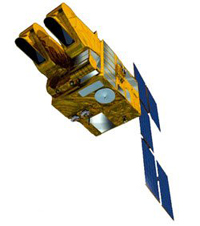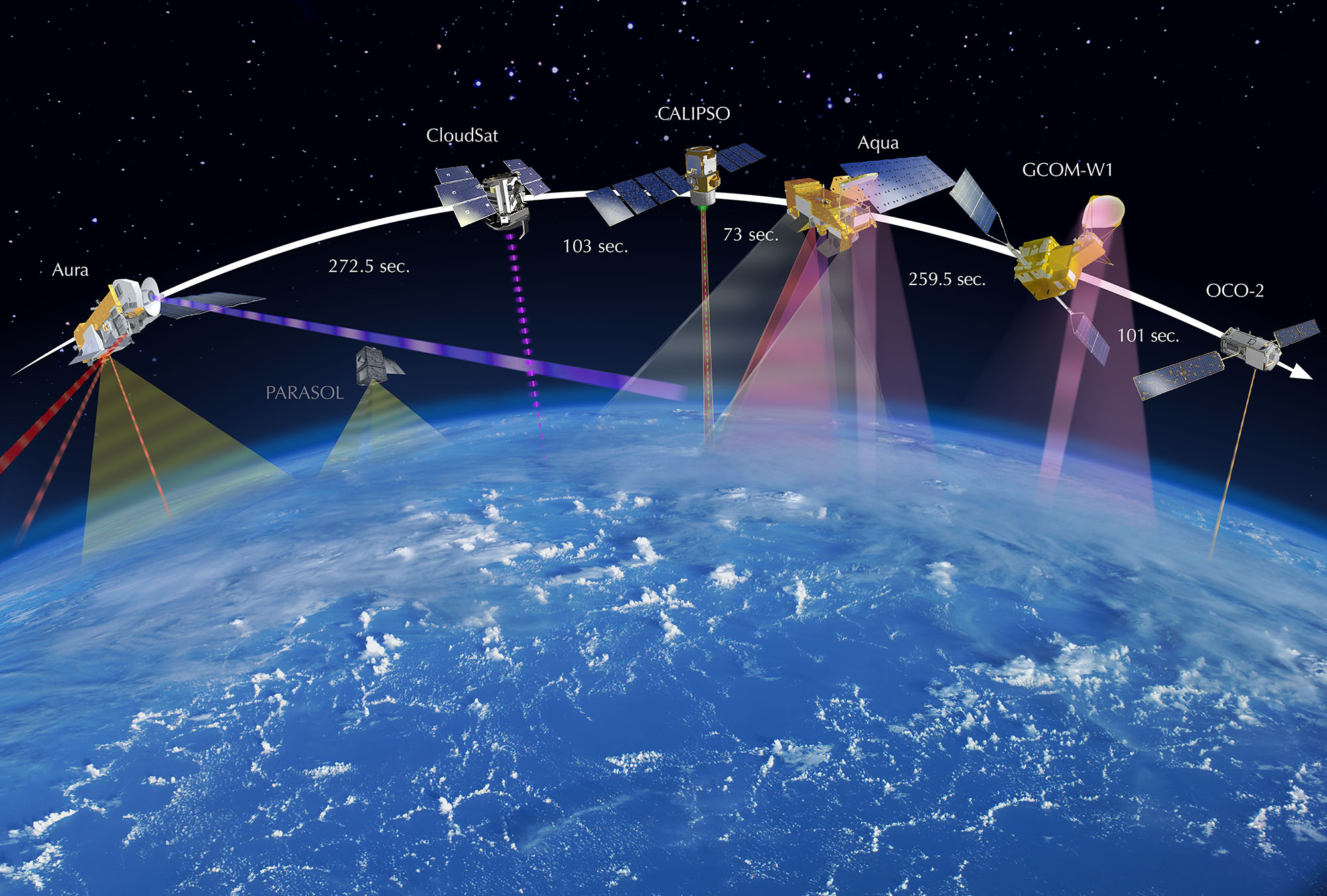|
KOMPSAT-2
KOMPSAT-2 (Korean Multi-purpose Satellite-2), also known as Arirang-2, is a South Korean multipurpose Earth observation satellite. It was launched from Plesetsk Cosmodrome, Russia at 07:45:43 Coordinated Universal Time, UTC (16:05:43 Korea Standard Time, KST) on 28 July 2006. It began to transmit signals at 14:00 UTC (23:00 KST) the same day. Like the earlier KOMPSAT-1 satellite, it takes its name from the popular Korean folk song Arirang. Its launch was the culmination of a project begun in 1995. KOMPSAT-2 orbits at a height of , circling the Earth 14 times per day, and is expected to maintain that orbit for 3 years. It weighs . The satellite carries a Multispectral Camera (MSC) which can distinguish to a 100-cm resolution, allowing the identification of individual vehicles on the ground. The satellite was succeeded by KOMPSAT-3, KOMPSAT-5 and KOMPSAT-3A, which were launched in 2012, 2013 and 2015 respectively. History South Korea started the KOMPSAT programme in 1995 to nur ... [...More Info...] [...Related Items...] OR: [Wikipedia] [Google] [Baidu] |
KOMPSAT
KOMPSAT or Korean Multi-Purpose Satellite is a series of South Korean multipurpose satellite for Earth observation satellite, Earth observation, Communications satellite, communications, Weather satellite, meteorological, Biophysical environment, environmental, Agriculture, agricultural, and Oceanography, oceanographic monitoring applications. Satellites References External links {{KAI aircraft Satellites of South Korea South Korean spacecraft Satellites orbiting Earth Satellite series Korea Aerospace Industries spacecraft ... [...More Info...] [...Related Items...] OR: [Wikipedia] [Google] [Baidu] |
Korea Aerospace Industries
Korea Aerospace Industries, Ltd. (KAI; ) is a South Korean aerospace and defense manufacturer. It was originally established as a joint venture of Daewoo Heavy Industries' aerospace division, Samsung Aerospace, and Hyundai Space and Aircraft. p. 97 During 1999, KAI became more independent of its founding members, acquiring their aerospace interests at the behest of the South Korean government following the financial troubles of these companies that had resulted from the 1997 Asian financial crisis. KAI has developed various aerospace products, including the Korean Space Launch Vehicle-II (KSLV-II) and various satellites. It has been involved in the production of several foreign-designed aircraft via licensing arrangements, such as the MBB/Kawasaki BK 117, MBB Bo-105 KLH, and the KF-16. KAI has also developed and produced its own aircraft designs, including the KT-1 Woongbi and T-50 Golden Eagle training aircraft, the KC-100 Naraon general aviation aircraft, and the KU ... [...More Info...] [...Related Items...] OR: [Wikipedia] [Google] [Baidu] |
KOMPSAT-3
KOMPSAT-3 (Korean Multi-purpose Satellite-3), also known as Arirang-3, is a South Korean multipurpose Earth observation satellite. It was launched from Tanegashima Space Center, Japan at 16:39 UTC on 17 May 2012. Like the earlier KOMPSAT-1 and KOMPSAT-2 satellites, it takes its name from the popular Korean folk song Arirang. Its launch was the culmination of a project begun in 1995. KOMPSAT-3 orbits at a height of , circling the Earth 14 times per day, and is expected to maintain that orbit for 4 years. It weighs . The satellite carries an Advanced Earth Imaging Sensor System (AEISS), which can distinguish to a 70-cm resolution, allowing the identification of individual vehicles on the ground. The satellite was succeeded by KOMPSAT-5 and KOMPSAT-3A, which were launched on 2013 and 2015 respectively. History South Korea started the KOMPSAT programme in 1995 to nurture its national Earth-imaging industry and supply services for remote-sensing applications. The South Korean ... [...More Info...] [...Related Items...] OR: [Wikipedia] [Google] [Baidu] |
Satrec Initiative
Satrec Initiative Co., Ltd. (Satrec I; ) or SI is a South Korean satellite manufacturing company headquartered in Daejeon, South Korea The company was founded in 1999 by the engineers who developed the first Korean satellite ( KITSAT-1) at KAIST SaTRec ( Satellite Technology Research Center). The company designs and builds Earth observation satellites called SpaceEye-series, and it provides various space components, including high resolution electro-optical payloads and star-trackers. SI's first satellite was a Malaysian Earth observation satellite, RazakSAT launched in 2009. SI has two subsidiaries: SI Imaging Services (SIIS) is the exclusive image data provider of KOMPSAT-series, and SI Analytics (SIA) provides AI-native GEOINT solutions for satellite imagery. SI also spun-off SI Detection (SID), which provides radiation monitoring solutions. History Satrec Initiative was founded in Daejeon, South Korea in 1999. There are two subsidiaries established based on SI's business ... [...More Info...] [...Related Items...] OR: [Wikipedia] [Google] [Baidu] |
KOMPSAT-1
KOMPSAT-1 (Korean Multi-purpose Satellite-1), also known as Arirang-1, was a satellite created by the Korea Aerospace Industries (KAI) and Korea Aerospace Research Institute (KARI), and launched by a United States launch vehicle on 21 December 1999. This was the first satellite built primarily by South Korean engineers, although previous foreign-built satellites had been launched by Korean companies. It took its name from the popular Korean folk song Arirang. Instruments It carried an Electro-Optical Camera (EOC) able to distinguish objects with a diameter of with a footprint of 17 km. The satellite carried remote sensing instruments for providing digital cartography of Korea, and status of marine biology. Also included was the Ionospheric Measurement Sensor (IMS) to monitor ionospheric parameters along the satellite orbit and the High Energy Particles Detector (HEPD). High Energy Particle Detector (HEPD) The High Energy Particle Detector (HEPD) instrument consists ... [...More Info...] [...Related Items...] OR: [Wikipedia] [Google] [Baidu] |
Rokot
Rokot ( meaning ''Rumble'' or ''Boom''), also transliterated Rockot, was a Soviet Union (later Russian) space launch vehicle that was capable of launching a payload of into a Earth orbit with 63° inclination. It was based on the UR-100N (SS-19 Stiletto) intercontinental ballistic missile (ICBM), supplied and operated by Khrunichev State Research and Production Space Center. The first launches started in the 1990s from Baikonur Cosmodrome out of a silo. Later commercial launches commenced from Plesetsk Cosmodrome using a launch ramp specially rebuilt from one for the Kosmos-3M launch vehicle. The cost of the launcher itself was about US$15 million in 1999; The contract with European Space Agency (ESA) for launching Swarm in September 2013 was worth €27.1 million (US$36 million). Specifications Rokot's total mass was 107 tonnes, its length 29 metres and its maximum diameter 2.5 metres. The liquid-fueled launch vehicle comprised three stages. The lower two were based o ... [...More Info...] [...Related Items...] OR: [Wikipedia] [Google] [Baidu] |
KOMPSAT-5
KOMPSAT-5 (Korean Multi-purpose Satellite-5), also known as Arirang-5, is a South Korean observation satellite launched by Korea Aerospace Research Institute on August 22, 2013. It is a low-orbit satellite with an operational orbit of 550 km. Development KOMPASAT-5 was developed with a total project cost of 238.1 billion won from June 2005. The Ministry of Science, ICT and Future Planning, the Ministry of Trade, Industry and Energy, etc. jointly initiated the project, and related industries such as the Korea Aerospace Research Institute, Korea Aerospace Industries, Korean Air, Hanwha, Doosan Heavy Industries, and Satrec Initiative participated in the development. Technology It is the first South Korean satellite to be equipped with a synthetic-aperture radar, making it an all-weather Earth observation satellite that can precisely observe the Earth in high resolution even in bad weather such as cloudy days and at night. Its operational orbit is 550 km. While the existing ... [...More Info...] [...Related Items...] OR: [Wikipedia] [Google] [Baidu] |
Korea Aerospace Research Institute
The Korea Aerospace Research Institute (KARI; ), established in 1989, is the aeronautics and space agency of South Korea. Its main laboratories are located in Daejeon, in the Daedeok Science Town. KARI's vision is to continue building upon indigenous launch capabilities, strengthen national safety and public service, industrialize satellite information and applications technology, explore the Moon, and develop environmentally-friendly and highly-efficient cutting-edge aircraft and core aerospace technology. Current projects include the KSLV-2 launcher. Past projects include the 1999 Arirang-1 satellite. The agency was founded in 1989. Prior to South Korea's entry into the Institute for Advanced Engineering (IAE) in 1992, it focused primarily on aerospace technology. As of May 2024, KARI is an affiliated research institute of the Korea AeroSpace Administration. Background KARI began on October 10, 1989, as a national aerospace research institute with the purpose of contrib ... [...More Info...] [...Related Items...] OR: [Wikipedia] [Google] [Baidu] |
KOMPSAT-3A
KOMPSAT-3A (Korean Multi-purpose Satellite-3A), also known as Arirang-3A, is a South Korean Earth observation satellite equipped with a 55cm-resolution electro-optical camera and an infrared sensor developed by the Korea Aerospace Research Institute. It was launched on March 26, 2015. Development KOMPSAT-3A was developed by the Korea Aerospace Research Institute over eight years from December 2006 with a total project cost of 235.9 billion won. Four companies, including Korean Air, Hanwha, Satrec Initiative, and the AP System- Korea Aerospace Industries consortium, participated in the private sector bid for satellite development that closed in 2009. All of these companies participated in the development of KOMPSAT-1 and KOMPSAT-2. The KAI-AP Aerospace consortium was responsible for manufacturing the main body after receiving technology of KARI, while Korean Air, Doowon Heavy Industries, Hanwha, Alpion, Setrec Initiative, and Samsung Thales were in charge of the main body an ... [...More Info...] [...Related Items...] OR: [Wikipedia] [Google] [Baidu] |
Spot Image
Spot Image, a public limited company created in 1982 by the French Space Agency, Centre National d'Etudes Spatiales (CNES), the IGN, and Space Manufacturers (Matra, Alcatel, SSC, etc.) is a subsidiary of Airbus Defence and Space (99%). The company is the commercial operator for the SPOT Earth observation satellites. Network and partners Spot Image is a worldwide distributor of products and services using imagery from Earth observation satellites and works through a network of subsidiaries, local offices (Australia, Brazil, China, United States, Japan, Peru, Singapore), and partners. The goal is to provide on-the-spot service with worldwide availability. Spot Image works with a network of more than 30 direct receiving stations handling images acquired by the SPOT satellites. Spot Image collaborates with EU's GMES/Copernicus programme, shares geographic information with the OGC and contributes to the interoperability of web services; with Infoterra Global it continues to offe ... [...More Info...] [...Related Items...] OR: [Wikipedia] [Google] [Baidu] |
Earth Observation Satellite
An Earth observation satellite or Earth remote sensing satellite is a satellite used or designed for Earth observation (EO) from orbit, including spy satellites and similar ones intended for non-military uses such as environmental monitoring, meteorology, cartography and others. The most common type are Earth imaging satellites, that take satellite images, analogous to aerial photographs; some EO satellites may perform remote sensing without forming pictures, such as in GNSS radio occultation. The first occurrence of satellite remote sensing can be dated to the launch of the first artificial satellite, Sputnik 1, by the Soviet Union on October 4, 1957. Sputnik 1 sent back radio signals, which scientists used to study the ionosphere. The United States Army Ballistic Missile Agency launched the first American satellite, Explorer 1, for NASA's Jet Propulsion Laboratory on January 31, 1958. The information sent back from its radiation detector led to the discovery of the Earth's Van ... [...More Info...] [...Related Items...] OR: [Wikipedia] [Google] [Baidu] |
Daejeon
Daejeon (; ) is South Korea's list of cities in South Korea, fifth-largest metropolis, with a population of nearly 1.5 million. Located in a central lowland valley between the Sobaek Mountains and the Geum River, the city is known both as a technology and research center, and for its close relationship with the natural environment. Daejeon serves as a hub of transportation for major rail and road routes, and is approximately 50 minutes from the capital, Seoul, by Korea Train Express, KTX or Suseo high-speed railway, SRT high speed rail. Daejeon (along with Seoul, Gwacheon and Sejong City) is one of South Korea's administration hubs. The city is home to 23 universities and colleges, including KAIST, Korea Advanced Institute of Science and Technology (KAIST) and Chungnam National University, as well as government research institutes, and research and development centers for many chaebols such as Samsung, LG, mostly located in the city's ''Daedeok Innopolis, Daedeok Yeongu Danj ... [...More Info...] [...Related Items...] OR: [Wikipedia] [Google] [Baidu] |



